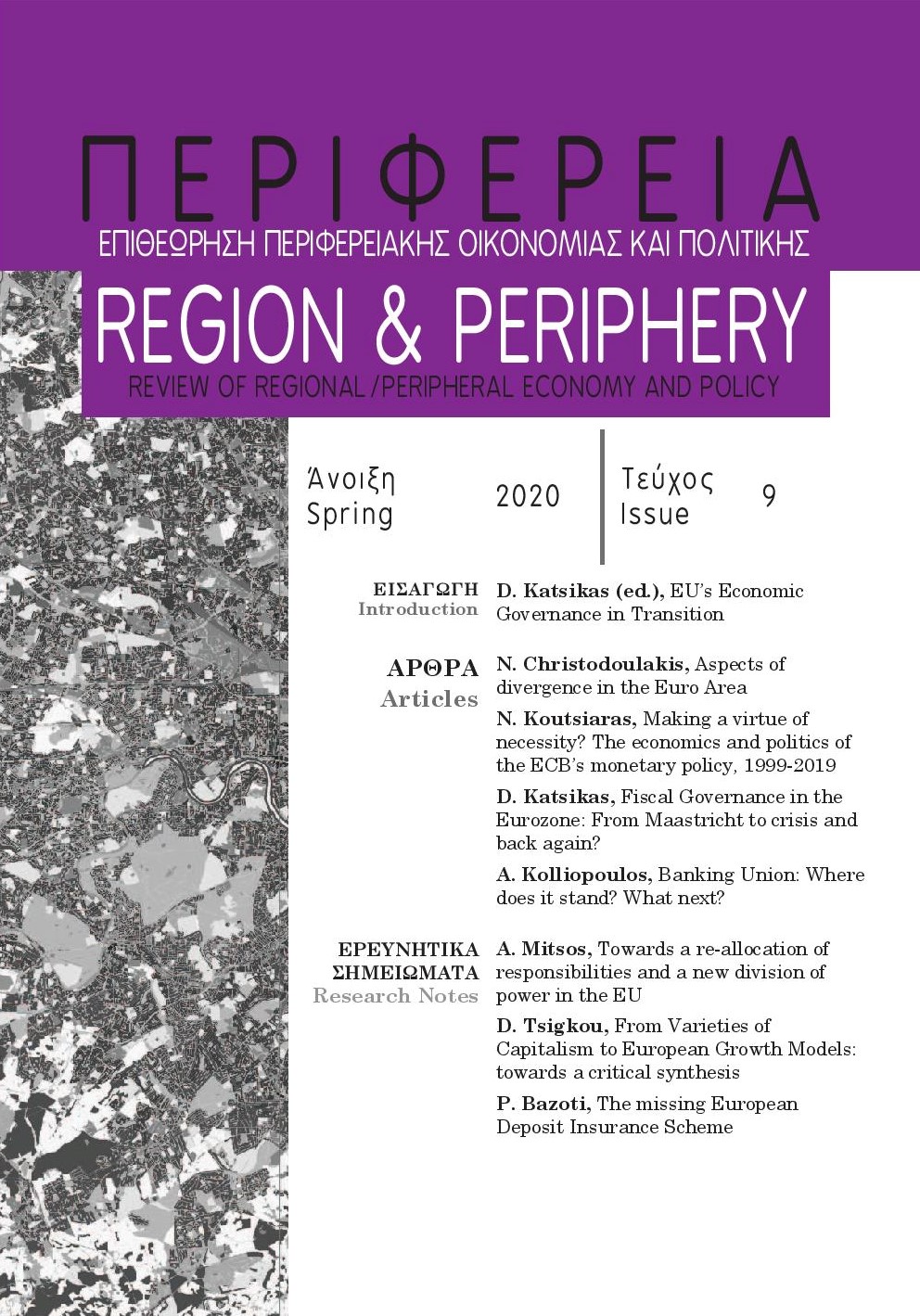Την ανάγκην φιλοτιμίαν ποιούμενη; Η πολιτική οικονομία της νομισματικής πολιτικής της ΕΚΤ, 1999-2019
Περίληψη
Η ΕΚΤ δεν θα ήταν δυνατόν να παραμένει πολιτικώς ουδέτερη – ούτε καν στην διάρκεια της πρώτης και σχετικώς ανέφελης περιόδου της νομισματικής ένω-σης. Είναι μια κεντρική τράπεζα χωρίς πατρίδα και τούτο συνεπάγεται την ανάγκη συμβιβασμών μεταξύ αποκλινουσών εθνικών προτιμήσεων νομισματικής πολιτικής. Τέτοιοι συμβιβασμοί επιτυγχάνονται, όμως, εις βάρος της θεωρητικής συνέπειας και της συνοχής της στρατηγικής νομισματικής πολιτικής. Και, αναπόφευκτα, αντανακλούν την επιρροή του κυριάρχου εταίρου στο Ευρωπαϊκό Νομισματικό Σύστημα, τουτέστιν πριν από την εγκατάσταση της νομισματικής ένωσης∙ αυτού που σήμερα καταβάλλει την μεγαλύτερη (εθνική) εισφορά στο κεφάλαιο της ΕΚΤ. Η πολιτική ουδετερότητα και, κατά την ίδια λογική, η προενεργός νομισματική πολιτική -όπως και η ρευστότητα- ήσαν ανεπαρκείς στην κρίση της ευρωζώνης, ιδίως κατά την αρχική φάση της. Ενισχύθηκαν κατόπιν, ωστόσο με βραδύ ρυθμό και τρόπο προτιμησιακό, δηλαδή, εν πολλοίς προς όφελος των τραπεζών. Η ΕΚΤ κάποια στιγμή, πράγματι, προσπάθησε να κάνει ό,τι μπορούσε -να κάνει την ανάγκη φιλοτιμία- όμως η δράση της δεν ήταν δυνατόν να παραγάγει μεγάλα αποτελέσματα. Η ΕΚΤ έγινε, διστακτικώς, ο μοναδικός πρωταγωνιστής. Οι δισταγμοί της απηχούσαν της ανησυχίες ορισμένων εθνικών κεντρικών τραπεζών, κυρίως της γερμανικής κεντρικής τράπεζας – και συνδέονταν με την επιβεβαίωση της νομισματικής κυριαρχίας, την παρεμπόδιση του (φαντασιακού) ενδεχόμενου πρόκλησης πληθωριστικών πιέσεων, την αποσόβηση του ηθικού κινδύνου, την προώθηση των διαρθρωτικών μεταρρυθμίσεων και, ασφαλώς, με την αποτροπή του ενδεχόμενου σχηματισμού, εμμέσως, μιας ένωσης μεταβιβάσεων. Η ΕΚΤ δεν θα μπορούσε να έχει μεγάλες φιλοδοξίες. Μπορεί να υπήρξε ο μοναδικός πρωταγωνιστής στη διαχείριση της κρί-σης, όμως υπολειπόταν των άλλων μεγάλων κεντρικών τραπεζών.
Λεπτομέρειες άρθρου
- Πώς να δημιουργήσετε Αναφορές
-
Κουτσιαράς Ν. (2020). Την ανάγκην φιλοτιμίαν ποιούμενη; Η πολιτική οικονομία της νομισματικής πολιτικής της ΕΚΤ, 1999-2019. Περιφέρεια | Regional Integration: Politics, Economics, Governance, (9), 37–82. https://doi.org/10.12681/rp.23791
- Ενότητα
- Ερευνητικά Άρθρα

Αυτή η εργασία είναι αδειοδοτημένη υπό το CC Αναφορά Δημιουργού – Μη Εμπορική Χρήση 4.0.
Οι συγγραφείς των άρθρων που δημοσιεύονται στο περιοδικό διατηρούν τα δικαιώματα πνευματικής ιδιοκτησίας επί των άρθρων τους, δίνοντας στο περιοδικό το δικαίωμα της πρώτης δημοσίευσης.
Άρθρα που δημοσιεύονται στο περιοδικό διατίθενται με άδεια Creative Commons 4.0 Non Commercial και σύμφωνα με την άδεια μπορούν να χρησιμοποιούνται ελεύθερα, με αναφορά στο/στη συγγραφέα και στην πρώτη δημοσίευση για μη κερδοσκοπικούς σκοπούς.
Οι συγγραφείς μπορούν να καταθέσουν το άρθρο σε ιδρυματικό ή άλλο αποθετήριο ή/και να το δημοσιεύσουν σε άλλη έκδοση, με υποχρεωτική την αναφορά πρώτης δημοσίευσης στο περιοδικό Περιφέρεια.
Οι συγγραφείς ενθαρρύνονται να καταθέσουν σε αποθετήριο ή να δημοσιεύσουν την εργασία τους στο διαδίκτυο πριν ή κατά τη διαδικασία υποβολής και αξιολόγησής της.



